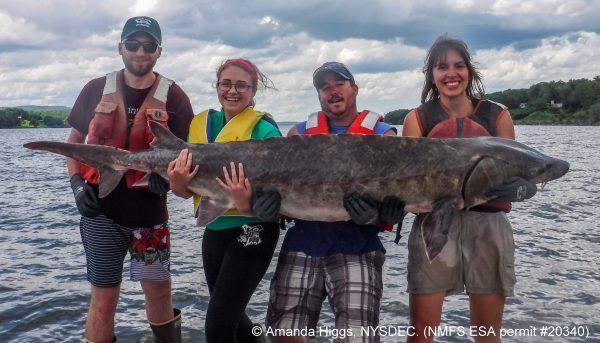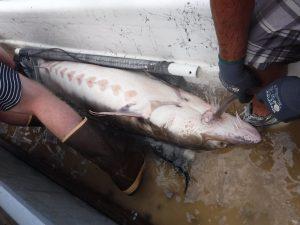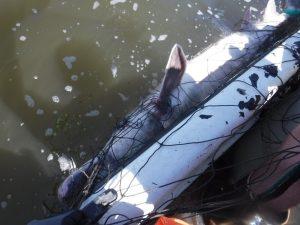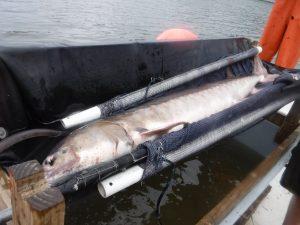-
About
- Leadership & Faculty
- News & Events
-
Academics
- Graduate
- Advanced Clinical Training
- Continuing Education
- Academic Offices
-
Student Life
-
Research
-
Hospitals & Clinics
- Emergency Care
- Hospital Services
-
Community Outreach
- Volunteer
Catching Monster Fish in the Hudson River
Anne Christian, MCM’17 Externship Experience with New York State Department of Environmental Conservation (NYSDEC)

This summer I went on the ultimate fishing adventure. As part of the Masters in Conservation Medicine (MCM) Program at Tufts, I spent a month collecting parasite samples from Atlantic sturgeon, the largest fish in the Hudson River. I partnered with the New York State Department of Environmental Conservation (NYSDEC) to join their annual survey of spawning Atlantic sturgeon. My goal is to study how parasite levels in sturgeon vary from the start to the end of the spawning season.
This project has been a fun adventure in fieldwork, teaching me how to conduct my own research project and gather data from wild animals. Here are some of the advantages of fieldwork over indoor science:
-The daily uniform is hard to beat. No suits or lab coats here: I was a style icon in my daily outfit of basketball shorts, duck hunting boots, and highlighter-yellow lifejacket.
-The scenery is not terrible. I lived in a cabin right on the Hudson during my externship. Often we would see bald eagles hunting and great blue herons nesting while we were out on the river.
-Sometimes you get to see the sunrise, on the days when your workday starts at 5 am.
The Majestic Atlantic Sturgeon
Atlantic sturgeon look like they were designed as a compromise between the Sharknado creative team and a Pixar animator. The result is an animal with the body of a shark, the armor of a tank, the suction mouthparts of a mosquito, a dolphin-like urge to leap gracefully out of the water, and an eternal expression of bewilderment. As they have no teeth, their main defense lies in the large bony plates (called “scutes”) that cover their body.
Atlantic sturgeon reside in the Atlantic Ocean but migrate upriver annually to spawn, traveling hundreds of miles. They are a beloved local mascot: a picture of them adorns the signs that indicate watersheds of the Hudson. Specimens have been recorded as large as 800 pounds and 14 feet long. These fish evolved in the late Triassic/early Jurassic, earning them the nickname “dinosaur fish.” Atlantic sturgeon were heavily overfished in the 1800s, and environmental damage caused the population to decline even further. Conservation of Atlantic sturgeon is vital to the preservation of the history and heritage of the Hudson River.
A Day of Fishing
We set out each day in the boat from Norrie Point near Staatsburg, New York. Fishing begins by placing three nets at slack tide, the time when the river moves the slowest. Each net is about 300 feet long and 12 feet wide with anchors and buoys to hold the net in position. The nets are set by first throwing in an anchor and a buoy, and the net is unfurled like how a long carpet is unrolled into a hallway. Fish collide with the net underwater and become entangled.
If you had interviewed me before the project began, I would never have believed that this setup would ever work. The Hudson River is over 100 feet deep in some places, so I was skeptical that any fish would swim into the nets, let alone become entangled in the gaping 11-inch net openings. Fortunately for the sake of my project, I was wrong about this: we caught exactly 100 fish in total over the entire spawning season.
Now the fun part begins: hauling in the nets! All operations on the boat are powered by human muscle: two people haul each net in hand-over-hand, getting an excellent core and upper body workout. Once a sturgeon is drawn to the surface in the net, ropes are placed around its body and tail to restrain it while a technician disentangles it from the net, a job typically made difficult by the sturgeon’s refusal to cooperate. Sturgeon are kept in a floating “pen” tied beside the boat.
Collecting Samples
Once all sturgeon are collected from the nets, we analyze them one by one. Measurements are taken for length and weight, and sex is determined using a tool unceremoniously named “the violator.” Each sturgeon is scanned for a pit tag, which work like a microchip and give each sturgeon a unique ID. If the sturgeon lacks a pit tag, one is inserted.
I collect my own samples for my parasite project: any large external parasites that could be pulled off with tweezers, scrape samples from the operculum (the flap covering the gills) and from the area around the anal opening, and blood samples. The vein is not very close to the surface of the skin, and my 1.5-inch needles are just barely long enough to collect blood. After processing, each sturgeon is released back into the wild to continue its quest to reproduce. I am continuing my project by identifying and counting parasite specimens to determine how the progression of the spawning season affects parasite levels in sturgeon.
Takeaways from this experience:
-Flexibility and patience are key parts of field research. There is no nice laboratory bench to arrange your equipment, nor do you get infinite time to collect samples. Some fish were released without acquiring blood samples because the boat was rocking too much to get a clean jab. I had to learn to work efficiently in less-than-ideal working conditions.
-Nature is full of surprises. The Hudson River hides fascinating creatures that have a strange beauty of their own, enormous fish that have prowled these waters for millions of years. Atlantic sturgeon are a window back in evolutionary time and a view into the secrets of the Hudson River.
-Even the non-cuddly animals deserve love.



